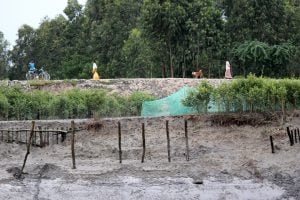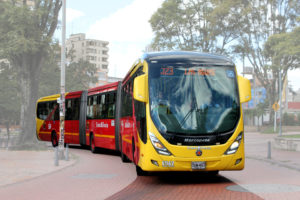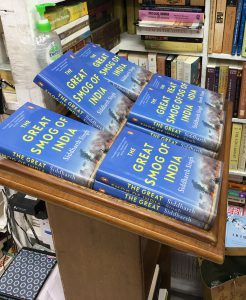Haji Mohammad Islam sleeps well these days. His brick kiln in Lahore’s Raiwind (27 kilometres from the city centre), is among the handful of kilns that will continue happily baking away thousands of bricks this month and even the next. In contrast the hum of an estimated 11,000 big and small kilns scattered through the various parts of the Punjab province will be silenced from November 3 until December 31 – a period now called the ‘smog season’.
Islam’s calm is the result of a visit to Nepal last year. That trip was facilitated by the International Centre for Integrated Mountain Development (ICIMOD) in collaboration with the Environment Protection Department, Punjab (EPD, Punjab) and National Energy Efficient Conversation Authority (NEECA), to apprise the Pakistani brick kiln owners of the zigzag brick kiln technology. Islam came back completely convinced and immediately converted his furnace.
Bidya Banmali Pradhan, programme coordinator of the brick initiative at ICIMOD explained the zigzag technique and its multiple benefits. “The emission reduction in zigzag kilns is around 60% of black carbon and 40% of particulate matter, which turns the plume of black smoke into a less dense white smoke.” Moreover, the zigzag kiln is energy-efficient and reduces the use of coal by around 20%, and baked bricks are 90% ‘A’ class bricks compared to only 60% baked in the conventional ones.
![Labourers working at the brick kilns in Punjab, Pakistan [image by: Ghulam Rasool]](https://dialogue.earth/content/uploads/2018/10/B6H7684_2372.jpg)
Mysterious but lethal
People today know that the mysterious cloak of smog which they once thought was fog and which routinely covers Lahore November onwards is killing them.
According to the World Health Organization, an estimated 60,000 Pakistanis died from exposure to higher levels of fine particulate matter (PM 2.5) in 2015. And itchy eyes and sore throat are not the only symptoms that are caused by it. There is clear evidence that polluted air causes depression, Alzheimer’s, even poor academic performance.
The decision to close kilns was taken by the Punjab government in consultation with the Smog Commission (constituted last year in Dec 2017 by the Lahore High Court) tasked to identify the root causes, formulate a policy and prescribe a plan to protect the health of the people.
“We had all the stakeholders on board like the transporters, the industry people, farmers associations, solid waste management board, the brick kiln owners and though the latter are definitely not the biggest emitters, they were the first to volunteer compliance,” said senior advocate of the Supreme Court of Pakistan, Pervaiz Hassan, who is the chairman of the commission.
“When the commission told us we were among the polluters, we were all very willing to do all we can to help,” said Mehar Abdul Haq, Secretary General of the All Bricks Kiln Owners Association of Pakistan (APKOA), who admitted experiencing the ill effects of smog since the last two years.
But despite a win-win for everyone, no more than four dozen brick kilns have so far been converted.
“To ask someone to convert from something that they have been practicing for generations will take time,” pointed out Haq. In addition, it entailed an additional expense of PKR 2.5 million (USD 18,725) and required getting an electricity connection, which in itself was a gargantuan task.
He hoped the “government would meet us half way” and facilitate and ease their conversion process including “a one-window operation, facilitation in getting electricity connections at subsidized rates, a research and development department and trained technicians who can make the transition smooth” for them.
![The Pakistani government is putting in place ways to help the kiln factories [image by: Ghulam Rasool]](https://dialogue.earth/content/uploads/2018/10/MG_7397_2146-1-1.jpg)
But with the voluntary closure of kilns, many other businesses will also be affected including coal, transport, construction.
Bricks are used in nearly 80% of the construction in Punjab. The construction company that civil engineer Asad Ayub works for is already feeling the pinch. “The prices of bricks have escalated from PKR 8,000 (USD 60) to PKR 12,000 (USD 89) per 1,000 bricks. We cannot stop work because the contract has been signed,” he said. He also feared acute shortage of the material this winter.
In addition, how will the nearly 2.3 million daily wage earners working at the kilns be compensated? Haq said the issue had been taken care of and their association had decided to “continue paying them the same amount” despite the closure of kilns.
Getting kiln owners to comply may help in reducing smog, but without bringing the transport, industries and crop burning to heel, the impact may just be nominal.
Lahore among NO2 hotspots
A global list of the 50 worst air pollutant emission hotspots in the world by Greenpeace which analysed the satellite data generated by European Space Agency’s new satellite has ranked Lahore and the surroundings 30th.
Interestingly, said Lauri Myllyvirta, a clean air campaigner and energy analyst with Greenpeace, the highest nitrogen dioxide levels were detected not in Lahore’s downtown but around Sheikhupura (55 kilometres from Lahore), Sunder (13 kilometres) and Jamber (67 kilometres) where there is a an oil-fired power plant).
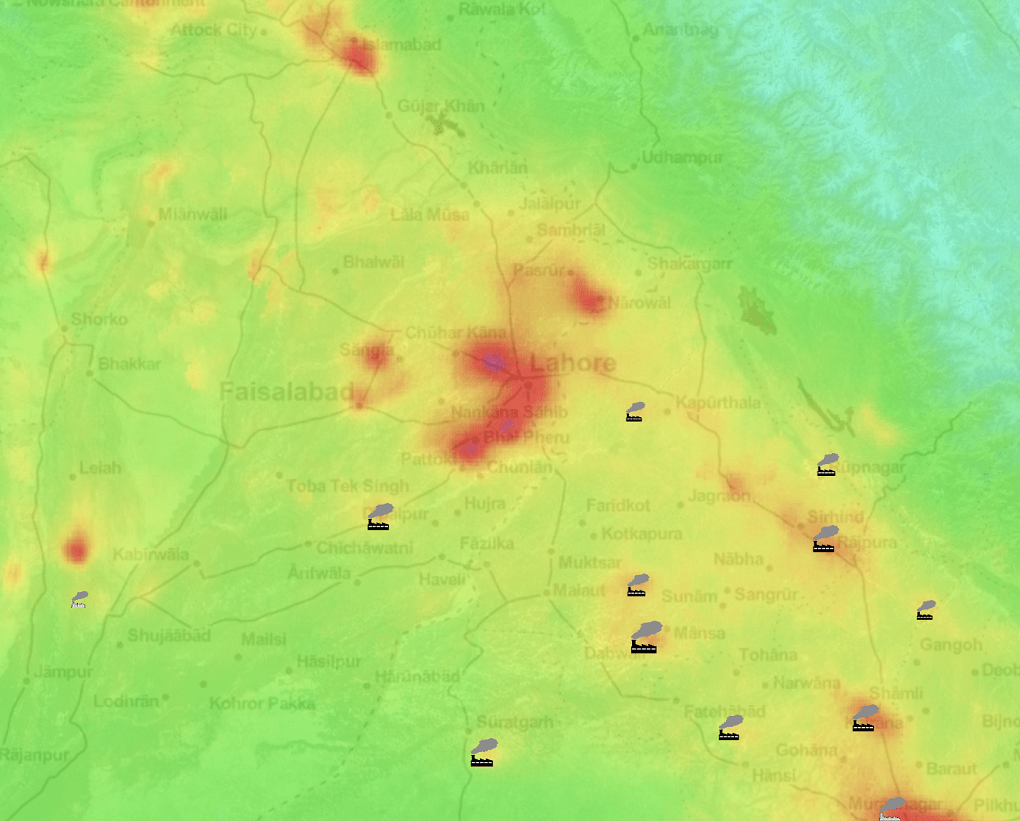
However, he said, the transport sector emissions were more spread across Lahore and likely to be the “largest contributor” overall.
But Myllyvirta pointed out, “The fact that I was able to find industries and power plant areas just by looking at the NO2 levels shows that these are significant sources affecting the air quality in Lahore.”
He thus concluded, “These findings emphasize the need for strong emissions limits and regulation for power plants, industry and vehicles, as well as shifting to cleaner energy sources and cleaner transport solutions.”
Government response
The government, said Aslam, was well aware of it and taking several steps including installation of scrubbers on steel mills in and around Lahore and take action against smoke emitting vehicles. In addition to tackling traffic pollution, Aslam said crop burning had been halted and the government was working on an alternate “zero tillage seeding” technology.
Hassan of the smog commission is trying out another alternative. “We are trying to get international rice buyers to put a condition that they will not buy from farms that practice crop burning.” It will be more effective, he said giving the example of how child labour was eliminated in a similar manner from the carpet industry when international pressure was mounted on the latter.
And while the government was managing the stubble burning this side of the border through both the carrot and stick approach, it remained helpless of the smoke billowing from across India.
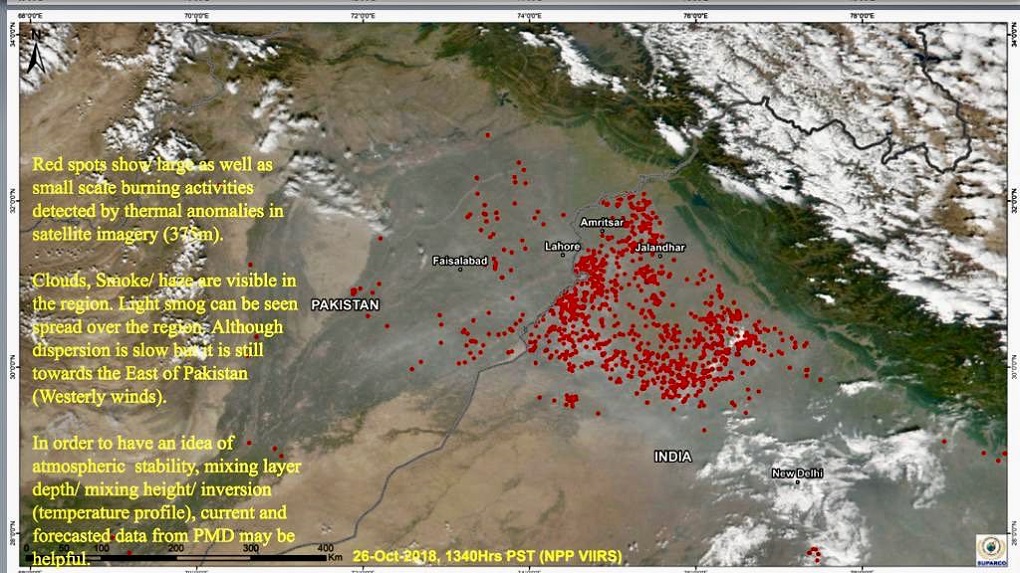
“We are tracking cross-border smog cloud through NASA/the national Space and Upper Atmosphere Research Commission satellite data and plan to initiate a dialogue with India through platforms such as South Asia Co-operative Environment Programme and World Meteorological Organization,” said Aslam and expressed yet another concern – the upcoming festival of Diwali in a week’s time. “It will add another large trigger into this cocktail of eco-pollution moving cross border”.
Not just emergency measures needed
But battling the smog has to be a continuous endeavour and not an exercise that takes place by the government at the onset of each winter, say experts. “The government is still trying to figure out how to handle smog,” said energy expert, Vaqar Zakaria, exasperated by the formers’ fire-fighting approach.
According to him, if the government would only take the time to do a “source apportionment” study on particulate matter, it would give a clear picture of exact pollutants and even the polluters, providing them to be better equipped to tackle the situation. “But who has the patience for science!” he lamented.
And yet data is what can make all the difference in tackling smog, according to Abid Omar, of the Pakistan Air Quality Initiative (PAQI), which provides real-time data on air quality in the country. “Punjab has eleven air quality monitors around Punjab, but does not have the capacity to run, manage or even disseminate information from them,” he said. He also remained sceptical of the steps taken by the Punjab government which he said lacked the “necessary depth and breadth” to address it.
“With limited data, limited expertise, an absence of source appropriation studies, lack of experts on board to analyze and recommend policies, the existing policy is merely reactionary,” said Abid. “The problem is much bigger than brick kilns and crop residue burning. The problem is of governance and until the government realizes that, the solutions are going to be superficial.”
Meanwhile, the fight against the much awaited smog continues. Hassan conceded the commission’s implementation may not be “5-star” yet, but they were trying to do their best in the short time frame given to them. “The commission was ordered by the Supreme Court just two weeks back to become implementers. But I promise the 2019 smog season will be easier for many!”
![<p>Most of Pakistan’s brick kilns in Punjab will be shut down between November 3 to December 31 to deal with smog [image by: Ghulam Rasool]</p>](https://dialogue.earth/content/uploads/2018/10/B6H7703_2391-Edit-1-1.jpg)


